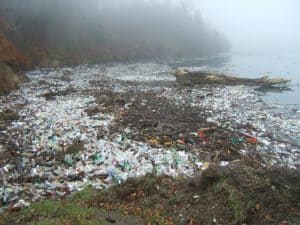Simply put, the truth about plastic is rather dire. In fact, every piece of plastic ever produced still exists! Some more interesting and unpleasant facts – all in the plastic infographic at the bottom of the page.
10 Simple Steps to Stop (or Significantly Reduce) Using Plastic
(Plus a Plastic Infographic)
Here are some easy to action steps, courtesy of World Ocean Observatory.

1. Avoid buying items with plastic packaging. Look for produce and other items that have little packaging. Also, buy food in glass jars, and detergents in boxes or refillable bottles. Not only are you reducing the plastic you use, you’re sending a solid message to the product makers that you don’t like plastic packaging.
2. Use cloth shopping bags (not even jute bags). Plastic bags are an eyesore and are dangerous to wildlife. Keep reusable bags somewhere handy – in your car or your bike or by the front door – so you remember them when you go to the market, grocery store or mall. Also, jute bags often have a plastic lining so better still, use a cotton bag.
3. Say no to bottled water. Carry a reusable canteen. Plastic bottles are one of the top five most common types of litter found on beaches. Also, bottled water is much more expensive than tap water which is perfectly fine to drink in many places. So you’ll also save money, and avoid the possible hazards of plastic toxins leaching into your beverage.
4. Upcycle. Think of new uses for old items rather than discarding them or buying new ones. By the way, this applies to everything, not just plastic items.
5. Bring a reusable mug when you order coffee. Stow it on your desk, in your purse, car or bag so you have it on hand when you order or refill your drink.
6. “No straw, please.” Straws are one of the top 10 items “inhabiting” beaches. In most cases, drinking out of a straw is simply unnecessary, oh, and it helps the creation of wrinkles around your lips. If you do need a straw, you can get a reusable stainless steel or glass one.
7. Wear clothing made from natural (not synthetic) materials. Wearing and washing clothes causes fibers to flake off, and polyester clothing is made of plastic. In fact, tiny particles of microplastic found in oceans around the world have been traced to such synthetic fabrics.
8. Avoid disposable tableware, or use the compostable kind. Try using washable and reusable cups, plates or utensils. When using compostable tableware, be aware they will not biodegrade in a landfill so you should dispose of in appropriate composting conditions.
9. Don’t just discard electronics. That’s everything from cables and batteries to large pieces like a TV. Aim to repair or upgrade your devices instead of buying new ones. Further, you can even make money – sell gadgets and computer parts, or find a facility where you can turn them in for recycling.
10. Finally, bring your own container for takeout and leftovers. When ordering takeout or bringing home leftovers, ask if you can get the food in your own reusable container.
Click to enlarge the plastic infographic:
Credit: Reuse this Bag
Check out our articles on Plastic Bag Usage, Plastic Bottles Recycling or Landfill, Plastic Recycling in Taiwan – Green Gold










That’s so true as plastics are non degradable, its won’t be wrong to say that every piece of plastic ever produced still exists. But this is hazardous for our environment. So we must reduce its usage and try to recycle plastic as much as possible!!
A fascinating…yet terrifying article! Plastics are indeed one of the greatest land pollution threats out there. Everywhere you turn in America, you find plastic bottles, plastic wrappers, etc., littering the roadsides.
Great Video… There is a very urgent need of licycreng plastic items or reduce plastic consumption. Because, plastic items which we throw outside releases harmful chemicals. Health will be effected due to these chemicals and cause many problems.